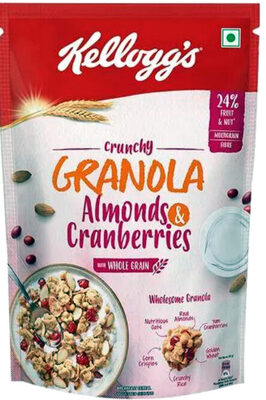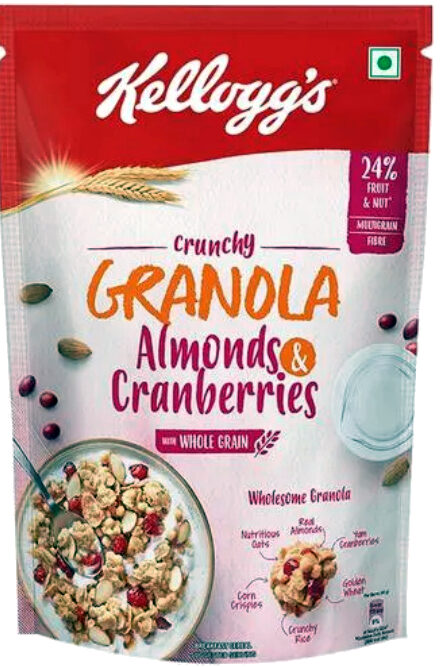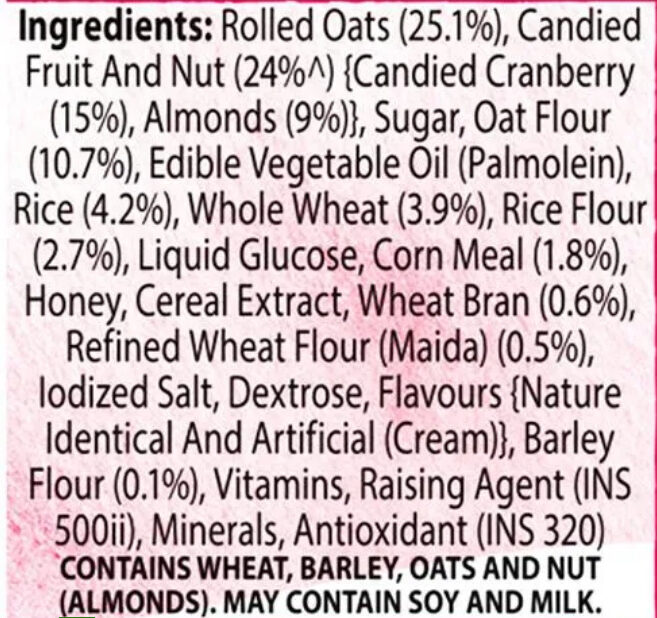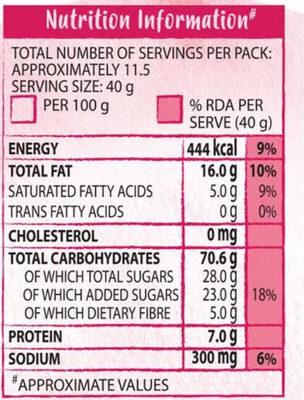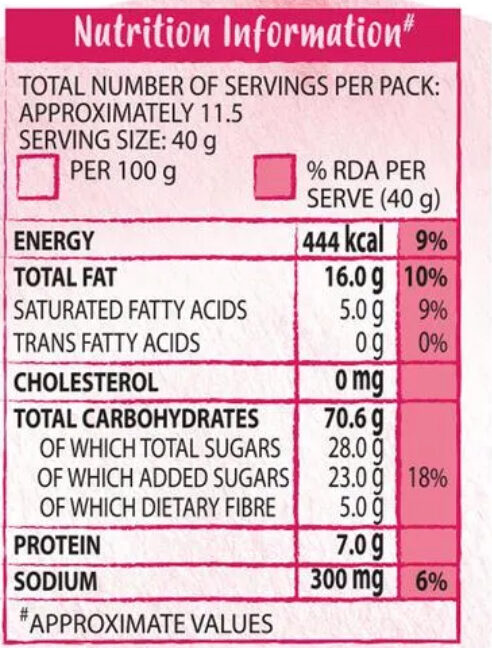Help us make food transparency the norm!
As a non-profit organization, we depend on your donations to continue informing consumers around the world about what they eat.
The food revolution starts with you!
Kelloggs Crunchy Granola Almonds & Cranberries - 460 g
Kelloggs Crunchy Granola Almonds & Cranberries - 460 g
Barcode: 8901499009715 (EAN / EAN-13)
Common name: Cereal
Quantity: 460 g
Packaging: Plastic, Pouch flask, Recyclable material, Recyclable plastic
Brands: Kelloggs
Categories: Plant-based foods and beverages, Plant-based foods, Snacks, Breakfasts, Cereals and potatoes, Sweet snacks, Cereals and their products, Bars, Breakfast cereals, Cereal bars, Nuts cereal bars, Cereal bar with almonds or hazelnuts, Cereal bar with almonds
Labels, certifications, awards:
Vegetarian, Green Dot, Green Dot India

Origin of the product and/or its ingredients: India
Origin of ingredients: India
Manufacturing or processing places: India
Traceability code: EAN CODE: 8901499011237, FSSAI NUMBER: 10013022002031
Stores: Bigbasket
Countries where sold: India
Matching with your preferences
Health
Ingredients
-
33 ingredients
Rolled Oats (25.1%), Candied Fruit And Nut (24%^) { Candied Cranberry (15%), Almonds (9%)}, Sugar, Oat Flour (10.7%), Edible Vegetable Oil (Palmolein), Rice (4.2%), Whole Wheat (3.9%), Rice Flour (2.7%), Liquid Glucose, Corn Meal (1.8%), Honey, Cereal Extract, Wheat Bran (0.6%), Refined Wheat Flour (Maida) (0.5%), lodized Salt, Dextrose, Flavours {Nature Identical And Artificial (Cream)), Barley Flour (0.1%), Vitamins, Raising Agent (INS 500ii), Minerals, Antioxidant (INS 320) CONTAINS WHEAT, BARLEY, OATS AND NUT (ALMONDS). MAY CONTAIN SOY AND MILK.Allergens: Gluten, Milk, NutsTraces: Milk, Soybeans
Food processing
-
Ultra processed foods
Elements that indicate the product is in the 4 - Ultra processed food and drink products group:
- Ingredient: Dextrose
- Ingredient: Flavouring
- Ingredient: Glucose
Food products are classified into 4 groups according to their degree of processing:
- Unprocessed or minimally processed foods
- Processed culinary ingredients
- Processed foods
- Ultra processed foods
The determination of the group is based on the category of the product and on the ingredients it contains.
Additives
-
E320 - Butylated hydroxyanisole (bha)
Butylated hydroxyanisole: Butylated hydroxyanisole -BHA- is an antioxidant consisting of a mixture of two isomeric organic compounds, 2-tert-butyl-4-hydroxyanisole and 3-tert-butyl-4-hydroxyanisole. It is prepared from 4-methoxyphenol and isobutylene. It is a waxy solid used as a food additive with the E number E320. The primary use for BHA is as an antioxidant and preservative in food, food packaging, animal feed, cosmetics, rubber, and petroleum products. BHA also is commonly used in medicines, such as isotretinoin, lovastatin, and simvastatin, among others.Source: Wikipedia
-
E500 - Sodium carbonates
Sodium carbonates (E500) are compounds commonly used in food preparation as leavening agents, helping baked goods rise by releasing carbon dioxide when they interact with acids.
Often found in baking soda, they regulate the pH of food, preventing it from becoming too acidic or too alkaline. In the culinary world, sodium carbonates can also enhance the texture and structure of foods, such as noodles, by modifying the gluten network.
Generally recognized as safe, sodium carbonates are non-toxic when consumed in typical amounts found in food.
-
E500ii - Sodium hydrogen carbonate
Sodium hydrogen carbonate, also known as E500ii, is a food additive commonly used as a leavening agent.
When added to recipes, it releases carbon dioxide gas upon exposure to heat or acids, causing dough to rise and resulting in a light, fluffy texture in baked goods.
It is generally recognized as safe (GRAS) by regulatory authorities when used in appropriate quantities and poses no significant health risks when consumed in typical food applications.
Ingredients analysis
-
Palm oil
Ingredients that contain palm oil: Palm olein
-
Non-vegan
Non-vegan ingredients: Honey, CreamSome ingredients could not be recognized.
We need your help!
You can help us recognize more ingredients and better analyze the list of ingredients for this product and others:
- Edit this product page to correct spelling mistakes in the ingredients list, and/or to remove ingredients in other languages and sentences that are not related to the ingredients.
- Add new entries, synonyms or translations to our multilingual lists of ingredients, ingredient processing methods, and labels.
If you would like to help, join the #ingredients channel on our Slack discussion space and/or learn about ingredients analysis on our wiki. Thank you!
-
Vegetarian
No non-vegetarian ingredients detected
Unrecognized ingredients: 24, Lodized-salt, Nature-identical-and-artificialSome ingredients could not be recognized.
We need your help!
You can help us recognize more ingredients and better analyze the list of ingredients for this product and others:
- Edit this product page to correct spelling mistakes in the ingredients list, and/or to remove ingredients in other languages and sentences that are not related to the ingredients.
- Add new entries, synonyms or translations to our multilingual lists of ingredients, ingredient processing methods, and labels.
If you would like to help, join the #ingredients channel on our Slack discussion space and/or learn about ingredients analysis on our wiki. Thank you!
-
Details of the analysis of the ingredients
We need your help!
Some ingredients could not be recognized.
We need your help!
You can help us recognize more ingredients and better analyze the list of ingredients for this product and others:
- Edit this product page to correct spelling mistakes in the ingredients list, and/or to remove ingredients in other languages and sentences that are not related to the ingredients.
- Add new entries, synonyms or translations to our multilingual lists of ingredients, ingredient processing methods, and labels.
If you would like to help, join the #ingredients channel on our Slack discussion space and/or learn about ingredients analysis on our wiki. Thank you!
: Rolled Oats 25.1%, Fruit, Nut (24%^, Cranberry, Almonds), Sugar, Oat Flour 10.7%, Edible Vegetable Oil (Palmolein), Rice 4.2%, Whole Wheat 3.9%, Rice Flour 2.7%, Glucose, Corn Meal 1.8%, Honey, Cereal, Wheat Bran 0.6%, Refined Wheat Flour (Maida), lodized Salt, Dextrose, Flavours, Nature Identical and Artificial (Cream), Barley Flour 0.1%, Vitamins, Raising Agent (e500ii), Minerals, Antioxidant (e320, ALMONDS)- Rolled Oats -> en:oat-flakes - vegan: yes - vegetarian: yes - ciqual_food_code: 9311 - percent_min: 25.1 - percent: 25.1 - percent_max: 25.1
- Fruit -> en:fruit - vegan: yes - vegetarian: yes - percent_min: 10.7 - percent_max: 21.8
- Nut -> en:nut - vegan: yes - vegetarian: yes - percent_min: 10.7 - percent_max: 19.2
- 24%^ -> en:24 - percent_min: 6.092 - percent_max: 16.632
- Cranberry -> en:cranberry - vegan: yes - vegetarian: yes - ciqual_food_code: 13113 - percent_min: 1.605 - percent_max: 2.88
- Almonds -> en:almond - vegan: yes - vegetarian: yes - ciqual_food_code: 15041 - percent_min: 0.963 - percent_max: 1.728
- Sugar -> en:sugar - vegan: yes - vegetarian: yes - ciqual_proxy_food_code: 31016 - percent_min: 10.7 - percent_max: 17.075
- Oat Flour -> en:oat-flour - vegan: yes - vegetarian: yes - ciqual_food_code: 9310 - percent_min: 10.7 - percent: 10.7 - percent_max: 10.7
- Edible Vegetable Oil -> en:vegetable-oil - vegan: yes - vegetarian: yes - from_palm_oil: maybe - percent_min: 4.2 - percent_max: 10.7
- Palmolein -> en:palm-olein - vegan: yes - vegetarian: yes - from_palm_oil: yes - ciqual_food_code: 16129 - percent_min: 4.2 - percent_max: 10.7
- Rice -> en:rice - vegan: yes - vegetarian: yes - ciqual_proxy_food_code: 9100 - percent_min: 4.2 - percent: 4.2 - percent_max: 4.2
- Whole Wheat -> en:whole-wheat - vegan: yes - vegetarian: yes - ciqual_food_code: 9010 - percent_min: 3.9 - percent: 3.9 - percent_max: 3.9
- Rice Flour -> en:rice-flour - vegan: yes - vegetarian: yes - ciqual_food_code: 9520 - percent_min: 2.7 - percent: 2.7 - percent_max: 2.7
- Glucose -> en:glucose - vegan: yes - vegetarian: yes - ciqual_proxy_food_code: 31016 - percent_min: 1.8 - percent_max: 2.7
- Corn Meal -> en:cornmeal - vegan: yes - vegetarian: yes - ciqual_food_code: 9615 - percent_min: 1.8 - percent: 1.8 - percent_max: 1.8
- Honey -> en:honey - vegan: no - vegetarian: yes - ciqual_food_code: 31008 - percent_min: 0.6 - percent_max: 1.8
- Cereal -> en:cereal - vegan: yes - vegetarian: yes - percent_min: 0.6 - percent_max: 1.8
- Wheat Bran -> en:wheat-bran - vegan: yes - vegetarian: yes - ciqual_food_code: 9621 - percent_min: 0.6 - percent: 0.6 - percent_max: 0.6
- Refined Wheat Flour -> en:refined-wheat-flour - vegan: yes - vegetarian: yes - ciqual_proxy_food_code: 9410 - percent_min: 0.1 - percent_max: 0.6
- Maida -> en:refined-wheat-flour - vegan: yes - vegetarian: yes - ciqual_proxy_food_code: 9410 - percent_min: 0 - percent_max: 0.6
- lodized Salt -> en:lodized-salt - percent_min: 0.1 - percent_max: 0.6
- Dextrose -> en:dextrose - vegan: yes - vegetarian: yes - ciqual_proxy_food_code: 31016 - percent_min: 0.1 - percent_max: 0.6
- Flavours -> en:flavouring - vegan: maybe - vegetarian: maybe - percent_min: 0.1 - percent_max: 0.6
- Nature Identical and Artificial -> en:nature-identical-and-artificial - percent_min: 0.1 - percent_max: 0.6
- Cream -> en:cream - vegan: no - vegetarian: yes - ciqual_food_code: 19402 - percent_min: 0 - percent_max: 0.6
- Barley Flour -> en:barley-flour - vegan: yes - vegetarian: yes - ciqual_food_code: 9550 - percent_min: 0.1 - percent: 0.1 - percent_max: 0.1
- Vitamins -> en:vitamins - vegan: yes - vegetarian: yes - percent_min: 0 - percent_max: 0.1
- Raising Agent -> en:raising-agent - percent_min: 0 - percent_max: 0.1
- e500ii -> en:e500ii - vegan: yes - vegetarian: yes - percent_min: 0 - percent_max: 0.1
- Minerals -> en:minerals - percent_min: 0 - percent_max: 0.1
- Antioxidant -> en:antioxidant - percent_min: 0 - percent_max: 0.1
- e320 -> en:e320 - vegan: yes - vegetarian: yes - percent_min: 0 - percent_max: 0.1
- ALMONDS -> en:almond - vegan: yes - vegetarian: yes - ciqual_food_code: 15041 - percent_min: 0 - percent_max: 0.1
Nutrition
-
Poor nutritional quality
⚠ ️Warning: the amount of fruits, vegetables and nuts is not specified on the label, it was estimated from the list of ingredients: 14This product is not considered a beverage for the calculation of the Nutri-Score.
Positive points: 5
- Proteins: 4 / 5 (value: 7, rounded value: 7)
- Fiber: 5 / 5 (value: 5, rounded value: 5)
- Fruits, vegetables, nuts, and colza/walnut/olive oils: 0 / 5 (value: 14.95, rounded value: 15)
Negative points: 18
- Energy: 5 / 10 (value: 1858, rounded value: 1858)
- Sugars: 6 / 10 (value: 28, rounded value: 28)
- Saturated fat: 4 / 10 (value: 5, rounded value: 5)
- Sodium: 3 / 10 (value: 300, rounded value: 300)
The points for proteins are not counted because the negative points are greater or equal to 11.
Nutritional score: (18 - 5)
Nutri-Score:
-
Nutrient levels
-
Fat in moderate quantity (16%)
What you need to know- A high consumption of fat, especially saturated fats, can raise cholesterol, which increases the risk of heart diseases.
Recommendation: Limit the consumption of fat and saturated fat- Choose products with lower fat and saturated fat content.
-
Saturated fat in moderate quantity (5%)
What you need to know- A high consumption of fat, especially saturated fats, can raise cholesterol, which increases the risk of heart diseases.
Recommendation: Limit the consumption of fat and saturated fat- Choose products with lower fat and saturated fat content.
-
Sugars in high quantity (28%)
What you need to know- A high consumption of sugar can cause weight gain and tooth decay. It also augments the risk of type 2 diabetes and cardio-vascular diseases.
Recommendation: Limit the consumption of sugar and sugary drinks- Sugary drinks (such as sodas, fruit beverages, and fruit juices and nectars) should be limited as much as possible (no more than 1 glass a day).
- Choose products with lower sugar content and reduce the consumption of products with added sugars.
-
Salt in moderate quantity (0.75%)
What you need to know- A high consumption of salt (or sodium) can cause raised blood pressure, which can increase the risk of heart disease and stroke.
- Many people who have high blood pressure do not know it, as there are often no symptoms.
- Most people consume too much salt (on average 9 to 12 grams per day), around twice the recommended maximum level of intake.
Recommendation: Limit the consumption of salt and salted food- Reduce the quantity of salt used when cooking, and don't salt again at the table.
- Limit the consumption of salty snacks and choose products with lower salt content.
-
-
Nutrition facts
Nutrition facts As sold
for 100 g / 100 mlCompared to: Bars Energy 1,858 kj
(444 kcal)+4% Fat 16 g -21% Saturated fat 5 g -47% Trans fat 0 g Carbohydrates 70.6 g +31% Sugars 28 g -7% Fiber 5 g +29% Proteins 7 g -17% Salt 0.75 g +175% Fruits‚ vegetables‚ nuts and rapeseed‚ walnut and olive oils (estimate from ingredients list analysis) 14.95 %
Environment
-
Eco-Score D - High environmental impact
⚠ ️The full impact of transportation to your country is currently unknown.The Eco-Score is an experimental score that summarizes the environmental impacts of food products.→ The Eco-Score was initially developped for France and it is being extended to other European countries. The Eco-Score formula is subject to change as it is regularly improved to make it more precise and better suited to each country.Life cycle analysis
-
Average impact of products of the same category: C (Score: 53/100)
Category: Cereal bar with almonds or hazelnuts
Category: Cereal bar with almonds or hazelnuts
- PEF environmental score: 0.51 (the lower the score, the lower the impact)
- including impact on climate change: 3.20 kg CO2 eq/kg of product
Stage Impact Agriculture
82.7 %Processing
8.5 %Packaging
4.7 %Transportation
3.2 %Distribution
1.0 %Consumption
0.0 %
Bonuses and maluses
-
Origins of ingredients with a high impact
Malus:
Environmental policy: -5
Transportation: 0
Origin of the product and/or its ingredients % of ingredients Impact India 100 %High
-
Ingredients that threatens species
Malus: -10
Contains palm oil
Tropical forests in Asia, Africa and Latin America are destroyed to create and expand oil palm tree plantations. The deforestation contributes to climate change, and it endangers species such as the orangutan, the pigmy elephant and the Sumatran rhino.
-
Packaging with a high impact
Malus: -15
Shape Material Recycling Impact 1 Bag Plastic Recycle High Pouch flask Unknown High ⚠ ️ The information about the packaging of this product is not sufficiently precise (exact shapes and materials of all components of the packaging).⚠ ️ For a more precise calculation of the Eco-Score, you can modify the product page and add them.
If you are the manufacturer of this product, you can send us the information with our free platform for producers.
Eco-Score for this product
-
Impact for this product: D (Score: 23/100)
Product: Kelloggs Crunchy Granola Almonds & Cranberries - 460 g
Life cycle analysis score: 53
Sum of bonuses and maluses: -25
Final score: 23/100
-
Carbon footprint
-
Equal to driving 1.7 km in a petrol car
320 g CO² per 100g of product
The carbon emission figure comes from ADEME's Agribalyse database, for the category: Cereal bar with almonds or hazelnuts (Source: ADEME Agribalyse Database)
Stage Impact Agriculture
76.4 %Processing
8.6 %Packaging
8.8 %Transportation
5.6 %Distribution
0.6 %Consumption
0.0 %
Packaging
-
Packaging with a high impact
-
Packaging parts
1 x Bag (Plastic)
Pouch flask
-
Packaging materials
Material % Packaging weight Packaging weight per 100 g of product Plastic
-
Transportation
-
Origins of ingredients
Origins of ingredients with a high impact
Origin of the product and/or its ingredients % of ingredients Impact India 100 %High
Threatened species
-
Contains palm oil
Drives deforestation and threatens species such as the orangutan
Tropical forests in Asia, Africa and Latin America are destroyed to create and expand oil palm tree plantations. The deforestation contributes to climate change, and it endangers species such as the orangutan, the pigmy elephant and the Sumatran rhino.
Report a problem
-
Incomplete or incorrect information?
Category, labels, ingredients, allergens, nutritional information, photos etc.
If the information does not match the information on the packaging, please complete or correct it. Open Food Facts is a collaborative database, and every contribution is useful for all.
Data sources
Product added on by openfoodfacts-contributors
Last edit of product page on by itsumit.
